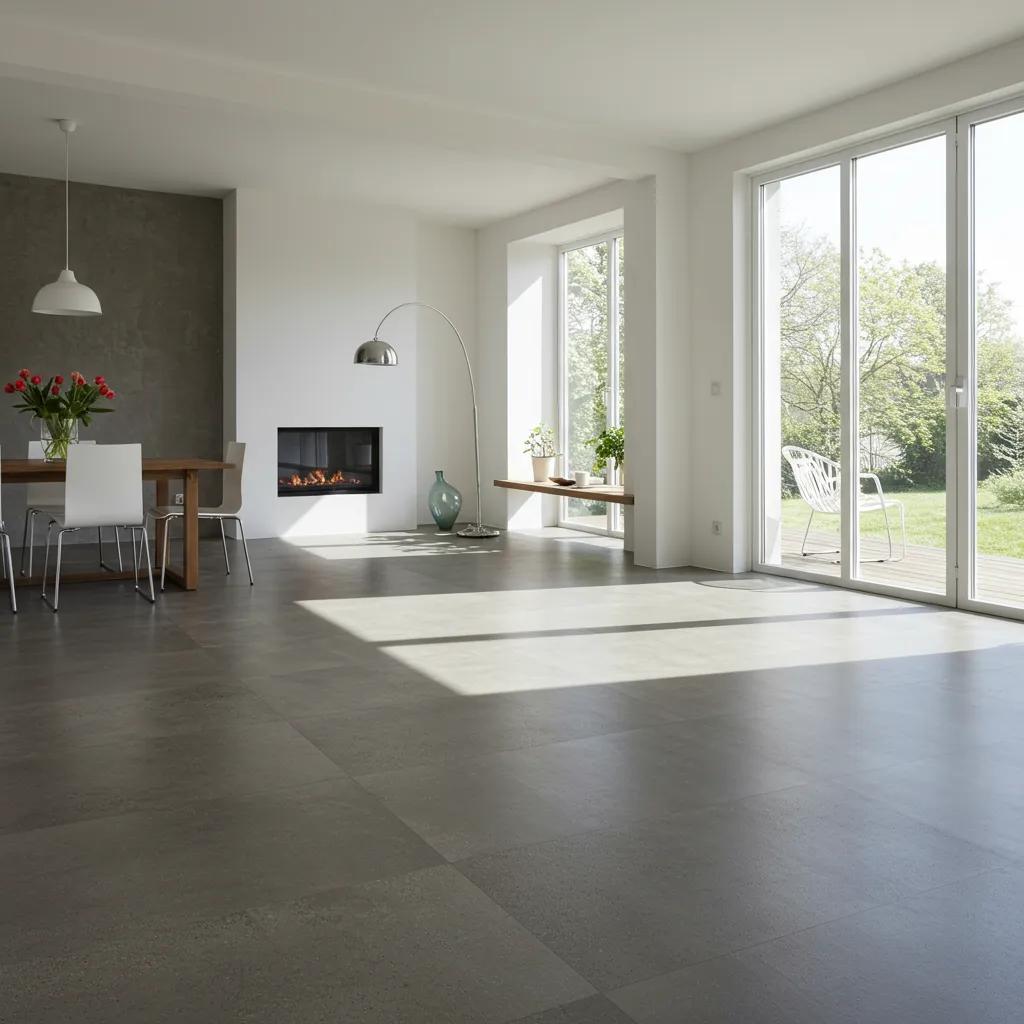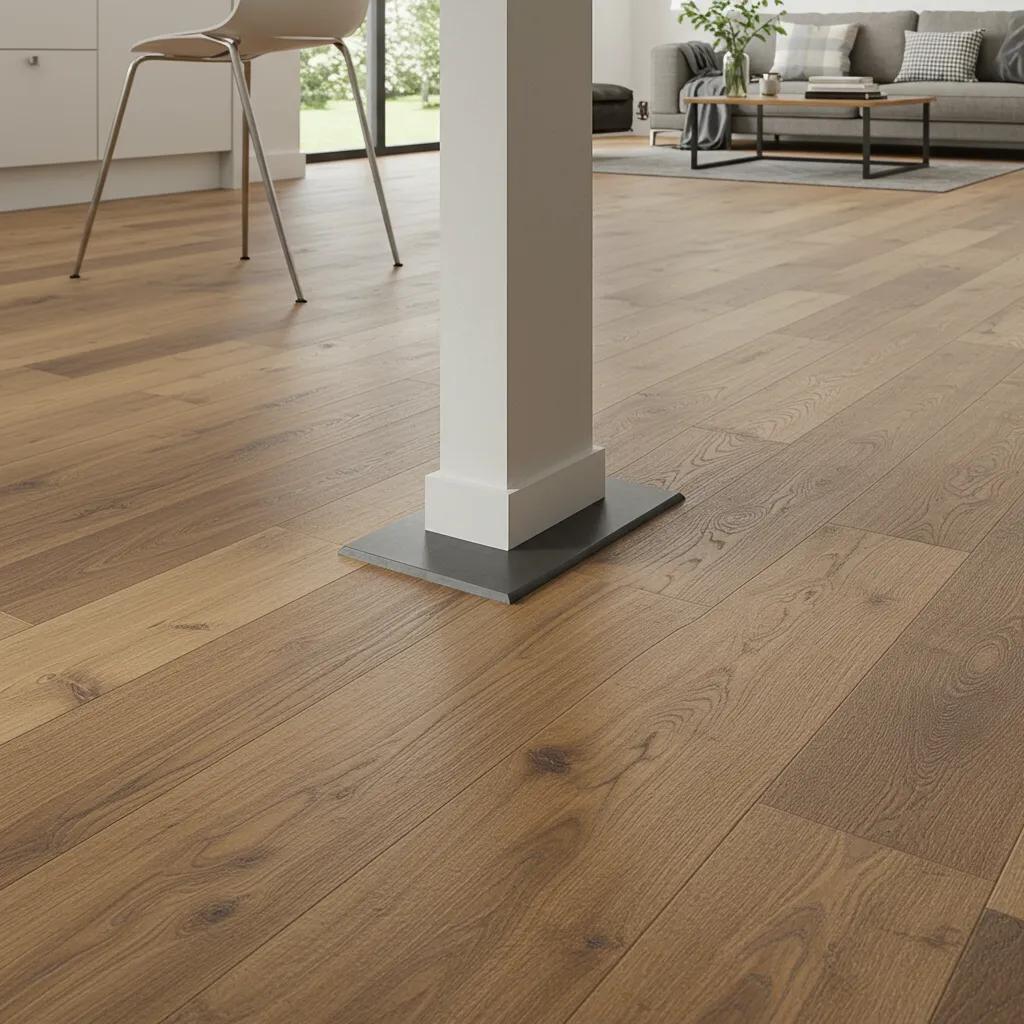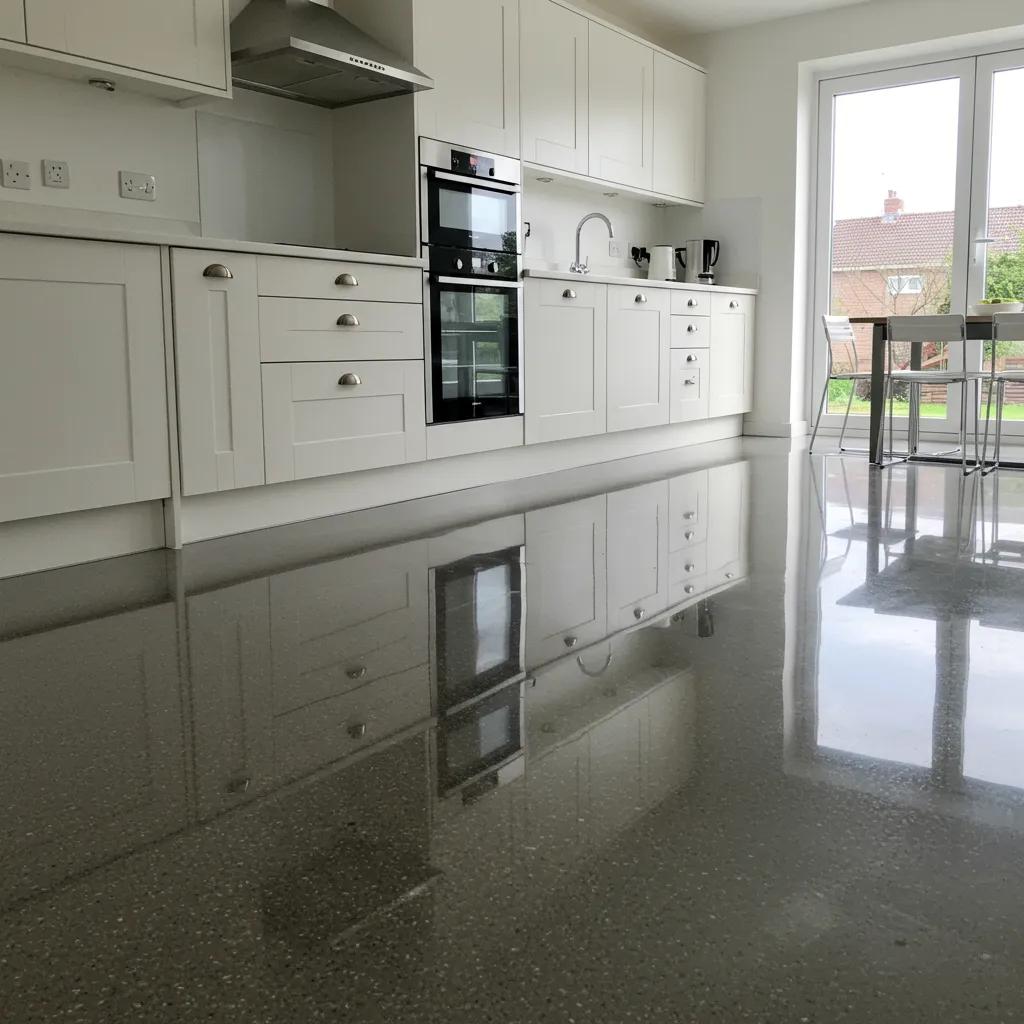Invisible Beauty: The Art of Seamless Flooring and Hidden Transitions

Seamless flooring unites form and function by creating continuous, joint-free surfaces that read as a single plane across rooms, levels and wet/dry junctions. This guide explains how micro-cement and resin flooring systems deliver that “invisible beauty” through material selection, technical detailing and hidden transitions while also addressing practical concerns such as waterproofing, underfloor heating compatibility and maintenance. Many homeowners and specifiers seek floors that extend visually across open-plan spaces without visible thresholds, and micro-cement and resin systems provide durable, hygienic and highly customisable options to achieve that. The article maps definitions and key material types, compares performance attributes, covers 2025 colour and texture trends, explains where these solutions work best, and walks through installation, DIY vs professional decisions and typical UK cost drivers. Read on for practical checklists, comparison tables and step-by-step guidance to help you plan seamless floors that both conceal transitions and perform reliably in busy domestic and commercial settings.
What Is Seamless Flooring and Why Is It the Future of Modern Design?
Seamless flooring is a class of floor finishes applied as continuous coatings or thin overlays that eliminate visible joints and grout lines, producing a uniform visual plane and improved hygiene. These systems work through layered construction — primer, base coats, reinforcement (where required) and pigmented sealed topcoats — to provide mechanical bonding to the subfloor and a continuous surface that resists moisture ingress and surface dirt. The result is visual continuity, simplified cleaning regimes and design freedom across open-plan layouts where minimalism and fluid circulation are priorities. Understanding how hidden transitions are achieved clarifies why designers increasingly specify seamless floors for both residential and commercial projects.
Seamless flooring creates invisible beauty in several ways:
- Material continuity: Matching the same finish across adjacent rooms removes visual breaks and makes spaces read larger and calmer.
- Edge detailing: Recessed profiles, tapered thresholds and level matching allow doorways and level changes to appear seamless.
- Colour and texture unity: Uniform pigments and consistent topcoats produce uninterrupted colour fields that align with minimalist 2025 trends.
These aspects make seamless flooring an attractive future-facing choice for modern design; next we examine the specific techniques that create hidden transitions.
How Does Seamless Flooring Create Invisible Beauty Through Hidden Transitions?

Hidden transitions are achieved by combining level control, matching surface treatment and discreet edge details so junctions read as part of the same surface rather than interruptions. Designers use tapered screeds, recessed metal edge trims set below the finished level, or continuous overlay systems that bridge small level changes to avoid raised thresholds. Material selection matters: thin micro-cement allows near-flush transitions to join timber or tile, while resin systems can be feathered to drains and up-wall junctions to maintain waterproof continuity. The visual impact is not just aesthetic: these approaches also reduce trip hazards and simplify cleaning regimes, which is particularly important in hospitality and healthcare settings.
Which Types of Seamless Flooring Are Most Popular in the UK?
Several hyponyms within seamless flooring dominate UK practice, each with distinct advantages and trade-offs: micro-cement, epoxy resin, polyurethane resin, MMA, polished concrete, liquid lino and seamless terrazzo overlays. Micro-cement offers a thin decorative cementitious finish ideal for vertical and horizontal continuity; epoxy and polyurethane resins provide hard-wearing, non-porous surfaces suited to hygiene-critical zones; MMA is valued for rapid cure in fast-turnaround projects; polished concrete and seamless terrazzo deliver robust, aggregate-based aesthetics for industrial and high-design schemes. Choosing between these options requires balancing aesthetic intent, performance attributes such as abrasion and chemical resistance, and installation complexity for the intended use.
What Are the Key Benefits of Micro-cement and Resin Flooring Solutions?
Seamless micro-cement and resin floors combine durability, waterproofing and design flexibility to suit a wide range of interiors and commercial spaces. Their continuous, non-grouted surfaces reduce dirt traps and deliver hygienic finishes, while robust topcoats provide abrasion and chemical resistance that prolongs service life. Aesthetic versatility ranges from warm, tactile micro-cement textures to high-gloss resin finishes and matte, low-reflectance options for minimalist schemes. Compatibility with underfloor heating and simple maintenance cycles further position these systems as modern, practical floor finishes for designers and facility managers alike.
Below are primary benefits to consider before specification:
- Durability and abrasion resistance: Micro-cement and high-performance resins resist everyday wear and maintain appearance with minimal restoration.
- Waterproofing and hygiene: Seamless, non-porous surfaces eliminate grout lines and reduce microbial harbourage.
- Aesthetic versatility: Wide palette of pigments and textural finishes supports everything from warm neutrals to statement colour.
- Low maintenance and serviceability: Routine cleaning is straightforward and localised repairs can be performed without wholesale replacement.
These benefits inform material selection — the table below compares typical performance attributes to guide choices.
This table compares three commonly specified seamless materials against key attributes to help you weigh performance, maintenance and finish options.
| Material | Key Attribute | Typical Performance |
|---|---|---|
| Micro-cement | Water resistance | Good when sealed; requires quality topcoat for wet areas |
| Epoxy resin | Durability & chemical resistance | High abrasion and chemical resistance; excellent for commercial use |
| Polyurethane resin | Flexibility & UV stability | Better impact resistance and UV tolerance; suitable for light-reflective finishes |
This comparison highlights trade-offs: micro-cement excels for tactile, continuous aesthetics while epoxy and PU resins lead on industrial performance. For purchasing guidance on product selection, see the practical integration that follows the next technical breakdown.
To provide useful information and guide users to discover and purchase a wide range of flooring products at competitive prices, ensuring customer satisfaction.
How Do Micro-cement Floors Offer Durability and Waterproof Performance?
Micro-cement is a polymer-modified cementitious overlay applied in thin layers (typically a few millimetres) over prepared subfloors; its strength derives from the cement matrix and polymer additives that improve adhesion and flexibility. A properly primed substrate, reinforcement mesh where needed and a protective topcoat or sealer are essential to achieve water resistance; without correct sealing micro-cement can be vulnerable to staining and moisture ingress. In practice, micro-cement performs well in domestic wet rooms and bathrooms when installers incorporate fully sealed upstands and flexible movement joints. Long-term durability depends on correct substrate preparation, quality of the system layers and topcoat maintenance cycles.
Why Is Resin Flooring Ideal for Hygienic and Easy-to-Clean Surfaces?

Resin flooring systems — including epoxy, polyurethane and MMA — form continuous, non-porous layers that are inherently easy to clean and resistant to bacteria harbourage due to the absence of joints. Epoxy resins offer excellent chemical and abrasion resistance, making them a frequent choice in commercial kitchens and healthcare settings where hygiene and spill resistance matter. Polyurethane variants provide improved UV stability and a degree of flexibility that benefits lighter traffic areas requiring a more aesthetic finish. Regular maintenance is typically straightforward: routine cleaning with neutral detergents and periodic inspection ensure long-term hygienic performance.
How Can You Achieve Modern Seamless Flooring Design with Hidden Floor Transitions?
Achieving contemporary seamless floors requires early coordination between architect, installer and client to determine colour, texture, transition detailing and interface with services like underfloor heating. Design-led choices such as pigment saturation, sheen level and micro-texture define whether the floor reads warm and tactile or crisp and minimal; these choices also affect slip resistance and perceived maintenance. Planning transitions at doors, between wet and dry zones and around fixed furniture ensures continuity without compromising accessibility. The next subsection outlines current colour and texture trends for 2025 and how to use them strategically.
Designers should consider these practical steps when planning seamless transitions:
- Plan zones by finish: Use slight texture or sheen shifts to define areas without physical thresholds.
- Match levels precisely: Coordinate screeding and subfloor heights early to avoid raised trims.
- Detail wet/dry junctions: Use integrated upstands or recessed drains to maintain continuity.
These measures support visual unity while preserving usability and safety across open-plan spaces.
What Are the Latest Colour and Texture Trends for Seamless Floors in 2025?
2025 trends favour warm neutrals and earthy tones that provide a gentle, timeless backdrop for interiors, with selective use of statement colours for feature areas and commercial brand spaces. Textural interest in micro-cement — soft trowel marks, gentle mottling — and subtle surface unevenness in matte resins offer tactile depth without adding visual clutter. Designers increasingly pair low-sheen finishes with soft furnishings and natural materials to create layered, calm interiors that read as continuous surfaces. Use of strategic colour contrast at focal areas, rather than across whole floors, allows zones to be emphasised while preserving overall seamless continuity.
How Do Hidden Transitions Enhance Open-Plan and Minimalist Interiors?
Hidden transitions extend sightlines and reduce perceptual clutter, making rooms feel larger and more cohesive, which is especially valuable in open-plan living and minimalist design. By removing traditional thresholds and grout lines, a single surface plane visually unites kitchen, dining and living areas while discreetly defining zones through furniture layout and subtle finish changes. This approach maintains functional separation — for example, slip-resistant finishes near wet zones — without interrupting the visual continuity that supports minimalist aesthetics. Practical detailing, such as recessed profiles and flush drainage, preserves usability while reinforcing the uninterrupted design language.
Where Are Seamless Flooring Solutions Best Applied Across Residential and Commercial Spaces?
Seamless flooring systems excel where continuity, hygiene or rapid cleaning are priorities, with applications ranging from domestic wet rooms to retail flagships and industrial production halls. In residences they work well for whole-flat overlays, bathrooms, kitchens and transitions to living spaces when specified with appropriate slip resistance and sealants. In commercial and industrial settings, epoxy and polyurethane resins provide chemical resistance and longevity under heavy traffic, while MMA can be chosen for rapid cure in refurbishment projects with tight schedules. Consideration of traffic type, exposure to chemicals and maintenance capacity determines which material family is most appropriate for a given site.
To provide useful information and guide users to discover and purchase a wide range of flooring products at competitive prices, ensuring customer satisfaction.
What Makes Micro-cement and Resin Flooring Suitable for Kitchens and Bathrooms?
Micro-cement and resin systems are popular in kitchens and bathrooms because they can be made waterproof at junctions, integrated with upstands and detailed around drains to create continuous wet-area envelopes. Slip-resistance options, such as textured topcoats or aggregate scatter finishes, are important in specifying for safety in wet rooms and busy kitchens. These materials also tolerate thermal inputs from underfloor heating when properly installed, offering comfortable, even heat distribution across the surface. The combination of waterproofing, hygiene and design flexibility makes them an attractive choice for modern wet-area design.
How Do Seamless Floors Perform in High-Traffic Commercial and Industrial Environments?
In high-traffic commercial and industrial contexts, resin systems selected for high abrasion and chemical resistance deliver the best lifespans and lowest maintenance overheads. Epoxy systems with broadcast aggregates or multi-layer PU flake finishes prevent rapid wear in retail and warehouse environments, while seamless terrazzo and polished concrete provide hardwearing, low-maintenance alternatives for heavy footfall public spaces. Regular maintenance regimes, including scheduled resealing and rapid repair of localised damage, preserve performance and aesthetic appearance. The combination of durability and hygiene benefits often reduces whole-life costs compared with conventional tiled or timber floors.
What Does the Installation and Maintenance Process Involve for Seamless Flooring?
Installation follows a defined sequence: site survey and subfloor assessment, remedial preparation, priming, base layers and reinforcement, pigmented finishing coats, and curing with final quality checks. Each phase has a required time and skill profile; substrate remediation and correct profiling are the most time-consuming but critical for longevity. Maintenance is typically straightforward — routine cleaning with neutral detergents and periodic re-sealing — but expectations differ by material: resins often need less frequent rework than thin decorative overlays. The table below clarifies installation steps and the typical time and skill required.
The following table maps installation phases to required time and skill to help plan schedules and decide whether to engage specialists.
| Phase | Installation Step | Time / Skill Required |
|---|---|---|
| Assessment | Site survey & moisture testing | 1 day; professional competence needed |
| Preparation | Levelling, repairs, priming | 1–3 days; skilled trades or specialist installer |
| Application | Base coats, reinforcement, finishing coats | 1–5 days; specialist installer recommended |
| Curing & QA | Curing time and final inspection | 1–7 days depending on system; professional QA advised |
Understanding these stages clarifies where professional expertise is essential and where simple maintenance will preserve the finish.
For hands-on guidance, below is a practical numbered list of the core steps for professional installation.
- Survey and testing: Conduct full subfloor inspection and moisture tests to determine remedial needs.
- Subfloor preparation: Repair cracks, level surfaces and apply primer for adhesion.
- Layer application: Install base coats, reinforcement mesh (if required) and apply decorative or pigmented topcoats.
- Curing and sealing: Allow proper cure times and apply protective sealants as specified by the system.
What Are the Steps for Professional Seamless Flooring Installation?
Professional installation begins with a detailed site survey that documents subfloor composition, moisture content and any defects requiring remediation; accurate assessment prevents later failures. Skilled preparatory work — grinding, levelling and priming — ensures the chosen overlay bonds and cures correctly; improper preparation is the most common cause of delamination. Layering then proceeds in controlled conditions, with each coating applied to specified thicknesses and cured to manufacturer guidance; installers monitor ambient temperature and humidity for optimal results. Final finishing and QA, including slip-resistance checks and aesthetic sign-off, complete the process and prepare the floor for handover.
Can You Install Seamless Flooring Yourself or Should You Hire Experts?
Some small projects and decorative micro-cement applications can be approached by experienced DIYers with the right tools and training, but most resin systems and critical wet-area installations are best installed by accredited professionals. DIY risks include inadequate substrate preparation, incorrect mix ratios, poor curing conditions and compromised waterproofing — all of which can shorten the floor’s life and increase long-term costs. When projects involve underfloor heating, drainage interfaces or commercial compliance requirements, hiring specialists with system warranties yields better outcomes and risk mitigation. If you choose DIY, invest in thorough training, follow manufacturer instructions exactly and plan for quality assurance checkpoints.
How Much Does Seamless Flooring Cost and What Factors Affect Pricing?
Typical UK price ranges vary by system, finish level and subfloor condition; as a representative example, epoxy resin systems often fall in the order of £60–£150/m² depending on specification and site conditions. Costs rise with extensive subfloor remediation, bespoke pigment or aggregate incorporation, and when rapid-cure products are selected for fast-track programmes. Project size matters: smaller areas have higher per-metre mobilisation and set-up costs while larger continuous areas benefit from economies of scale. Below is a table that clarifies common cost drivers and their typical influence on price.
The table summarises common cost factors and how they typically affect overall project pricing to help set realistic budgets and tender expectations.
| Cost Element | Typical Influence on Price | Notes |
|---|---|---|
| Subfloor condition | High | Major repairs or moisture remediation substantially increase cost |
| Area size | Medium | Small areas carry higher per-m² mobilisation costs |
| Finish level | Medium | Decorative aggregates, bespoke pigments and topcoat types raise prices |
| Labour availability | Medium | Specialist installers and rush programmes increase budget |
This breakdown shows that subfloor condition and finish choices are the most significant variables affecting final costs.
To provide useful information and guide users to discover and purchase a wide range of flooring products at competitive prices, ensuring customer satisfaction.
What Is the Typical Price Range for Micro-cement and Resin Flooring in the UK?
Representative price guidance helps set expectations: epoxy resin systems commonly range from about £60 to £150 per square metre depending on layers, aggregate and traffic requirements, while micro-cement tends to sit higher per square metre when applied as a decorative overlay because of the meticulous application and finishing required. Example inclusions in quotes often cover surface preparation, primer, base and finishing coats but can exclude structural repairs, drainage adjustments or bespoke coving. Always request itemised quotes that separate remedial works from material-and-labour costs to compare offers accurately and avoid surprises.
How Do Subfloor Conditions and Material Choices Influence Overall Cost?
Subfloor issues such as unevenness, cracks, dampness and weak screeds drive the need for levelling compounds, moisture remediation or even full removal and replacement, each adding to project cost and time. Material choices influence price through system complexity: multi-layer resin flake systems, broadcast aggregates and decorative terrazzo overlays require more material and labour than standard self-smoothing resin coatings. Choosing a simpler finish, coordinating larger continuous areas and executing remedial works in advance can reduce unforeseen extras. A pre-site survey and clear scope of works are the most effective ways to limit cost escalation.
- Plan a pre-survey: Commission a detailed subfloor assessment to forecast remedial costs.
- Compare itemised quotes: Seek line-by-line breakdowns to understand what is included.
- Choose finish pragmatically: Match aesthetic ambition with lifecycle expectations to control cost.
These actions help keep projects on budget while achieving the seamless aesthetic you want.


